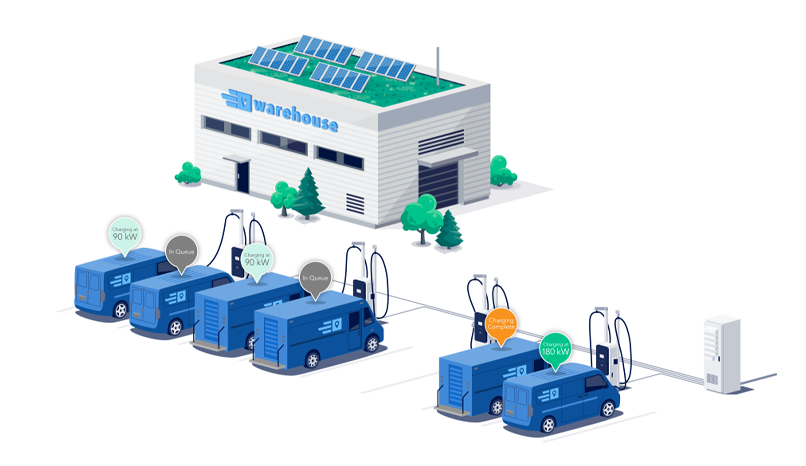
While vehicle types and fuel might have shifted from horses grazing on grain to cars guzzling oil or turning towards electrification, human nature remains the same. Fleet managers often put the cart before the horse when planning EV fleets—focusing on vehicle selection while treating charging infrastructure as an afterthought. This backward approach transforms infrastructure installation from a strategic consideration into what feels like an overwhelming added expense, explaining why so many fleet electrification projects are rushed, stall, or exceed budgets.
The reality is that vehicle procurement and charging infrastructure require strategic coordination from day one. More importantly, funding the project does not have to create operational headaches.
Fleet operators face unique challenges that distinguish them from individual EV buyers and commercial companies, and funding programs exist specifically to address these differences. These are not general EV incentives that fleets might qualify for—they are programs designed with fleet operations in mind.
Federal EV Funding Programs Target Specific Fleet Types
Federal funding demonstrates the strongest support for particular vehicle categories, with school buses receiving substantial attention through EPA programs focused on air quality concerns. Federal agencies prioritize reducing children’s exposure to diesel emissions, making school bus electrification a natural policy focus. The EPA has emerged as a primary advocate for school bus funding programs.
Transit operations also access dedicated federal funding streams, though these programs face greater uncertainty under shifting political priorities. Some established programs continue operating through existing Congressional appropriations.
The federal approach typically targets specific vehicle types rather than broad fleet electrification. Programs like NEVI, while primarily focused on public corridor charging, signal continued federal investment in charging infrastructure that may expand to include fleet-specific initiatives. Fleet operators with school buses or transit vehicles will find federal funding more accessible than those operating other vehicle types.

Fleet EV Charger Selection Checklist
Future-Proof Your Investment
Choosing the right EV chargers is a crucial decision for fleet managers, as it directly impacts operational efficiency, vehicle availability, charging costs, and the total cost of ownership. The right charging equipment makes the difference in properly charged vehicles and provides an option for future upgrades.
State and Local Programs Offer Primary Opportunities
State and local funding programs provide the most relevant opportunities for fleet EV charger grants and funding. These programs explicitly target fleet users and acknowledge the operational realities fleet managers face—particularly the need for “behind-the-fence” charging at private facilities as opposed to public charging networks.
State programs vary significantly by region but increasingly offer grants specifically for fleet charging infrastructure. Air quality districts have developed comprehensive programs serving both public and private fleets, recognizing that fleet electrification requires different infrastructure approaches than consumer EVs.
The advantage of state and local programs lies in their fleet-focused design. Unlike federal programs that may have been written for broader purposes, state initiatives often explicitly identify fleets as eligible participants and understand their operational requirements.
Local programs can supplement other funding sources effectively. Cities, counties, and regional authorities increasingly offer EV charger grants, recognizing the air quality and economic benefits of fleet electrification within their jurisdictions.
Utility Programs Provide the Most Accessible Pat
Utility companies offer some of the most accessible fleet-specific programs available. These programs typically feature shorter application timelines and less complex requirements than government grants while providing substantial rebates for charging equipment and installation costs.
Utility programs specifically target fleet operators installing multiple EV charging stations at depot locations. The application process for utility programs tends to be more straightforward than government grants. Utilities have clear business incentives to support fleet electrification, as it represents a significant new electrical load, motivating them to create workable programs.
Many utility incentive programs focus specifically on infrastructure costs—addressing charging stations rather than vehicles themselves. This approach aligns well with the biggest challenge fleet operators face: managing charging infrastructure expenses on top of vehicle acquisition costs.

Info
Did you know you can stack different types of funding?
Get the most of the funding available.
The Strategic Advantage of Layered Fundin
The most successful fleet electrification projects combine multiple EV funding grant sources rather than depending on single programs. State infrastructure grants can stack with utility rebates and local programs to cover significant portions of total project costs.
This layered approach requires additional research and application effort but can make projects financially viable even when individual funding sources provide incomplete coverage. Success depends on identifying which programs allow combination and which impose restrictions preventing stacking.
Some programs explicitly permit combining with other incentives, while others maintain restrictions. Understanding these parameters upfront prevents complications during project execution.
Taking Action on EV Fleet Charging Infrastructur
The funding landscape continues to evolve as federal programs like NEVI demonstrate ongoing commitment to charging infrastructure development. While these programs primarily focus on public charging corridors, they signal broader governmental support that may expand to include fleet-specific initiatives in the future.
The key lies in acting while programs remain active and accessible. Fleet operators who begin the funding research and application process now position themselves to take advantage of current opportunities and emerging programs as they develop.

Partner with BTC POWER for the Best Scalable EV Charging Infrastructure for Fleets
As North America’s leading EV charger manufacturer, BTC POWER combines superior American-made hardware with dedicated EV charger grants and funding expertise to help fleet operators navigate both technical requirements and available funding programs. Our comprehensive portfolio includes Level 2 solutions for smaller fleets and DC fast charging options like the GEN 4 All-in-One for heavy-duty operations.
Ready to explore funding opportunities for your fleet charging infrastructure? Contact BTC POWER today to discuss how our charging solutions can work with available funding programs to make your fleet electrification project financially viable.

